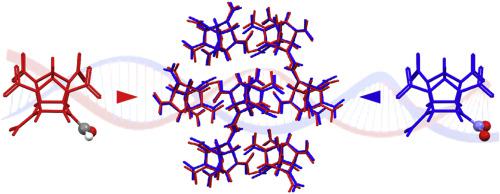Energetic Materials Frontiers ( IF 3.3 ) Pub Date : 2020-08-11 , DOI: 10.1016/j.enmf.2020.08.001 Yilin Cao , Tao Yu , Weipeng Lai , Yingzhe Liu , Bozhou Wang

|
Crystal packing modes determine the energy and safety performance of energetic materials (EMs) to some extent. To deepen the understanding of the intermolecular interactions in the crystal packings, the homologous molecular crystals of energetic materials were first defined according to the packing similarities in this study, and four groups of energetic homologous crystals with the same packing structures were found from the large experimentally available data. Several computational approaches were employed to comparatively probe the intermolecular interactions at molecular and crystal levels. The results of the analysis show that the common organic skeleton of two molecular conformations in each homologous packing structure remains the same or becomes mirror-symmetrical with a minor variation of functional groups, resulting in the local change of molecular electrostatic potentials, while the overall distribution of electrostatic potentials can be largely maintained. Compared with the other groups of homologous crystals, interestingly, the differences in intermolecular interactions in Group 4 are relatively large according to two-dimensional fingerprint plots and energy frameworks, indicating that the crystal packing of energetic materials is predominately caused by some types of intermolecular interactions. The results reported here are expected to inspire the constructions of energetic crystals with specific packing modes to improve performances, such as a minor modification to the molecular structure while keeping original crystal packing style.
中文翻译:

高能材料同源分子晶体中的分子间相互作用分析
晶体堆积模式在某种程度上决定了高能材料(EM)的能量和安全性能。为了加深对晶体堆积中分子间相互作用的理解,首先根据堆积相似性定义了高能材料的同源分子晶体,从大的实验中发现了四组具有相同堆积结构的高能同源晶体。可用数据。几种计算方法被用来比较探测分子和晶体水平上的分子间相互作用。分析结果表明,每个同源堆积结构中两个分子构象的共同有机骨架保持相同或镜像对称,官能团的变化很小,导致分子静电势的局部变化,而静电势的总体分布可以得到很大的维持。与其他同类晶体相比,有趣的是,根据二维指纹图和能量构架,第4组分子间相互作用的差异相对较大,这表明高能材料的晶体堆积主要是由某些类型的分子间相互作用引起的。此处报道的结果有望激发具有特定堆积模式的高能晶体的结构,以改善性能,例如在保持原始晶体堆积样式的同时对分子结构进行微小修改。同时可以很大程度上保持静电势的总体分布。与其他同类晶体相比,有趣的是,根据二维指纹图和能量构架,第4组分子间相互作用的差异相对较大,这表明高能材料的晶体堆积主要是由某些类型的分子间相互作用引起的。此处报道的结果有望激发具有特定堆积模式的高能晶体的结构,以改善性能,例如在保持原始晶体堆积样式的同时对分子结构进行微小修改。同时可以很大程度上保持静电势的总体分布。与其他同类晶体相比,有趣的是,根据二维指纹图和能量构架,第4组分子间相互作用的差异相对较大,这表明高能材料的晶体堆积主要是由某些类型的分子间相互作用引起的。此处报道的结果有望激发具有特定堆积模式的高能晶体的结构,以改善性能,例如在保持原始晶体堆积样式的同时对分子结构进行微小修改。根据二维指纹图和能量框架,第4组分子间相互作用的差异相对较大,表明高能材料的晶体堆积主要是由某些类型的分子间相互作用引起的。此处报道的结果有望激发具有特定堆积模式的高能晶体的结构,以改善性能,例如在保持原始晶体堆积样式的同时对分子结构进行微小修改。根据二维指纹图和能量构架,第4组分子间相互作用的差异相对较大,这表明高能材料的晶体堆积主要是由某些类型的分子间相互作用引起的。此处报道的结果有望激发具有特定堆积模式的高能晶体的结构,以改善性能,例如在保持原始晶体堆积样式的同时对分子结构进行微小修改。









































 京公网安备 11010802027423号
京公网安备 11010802027423号